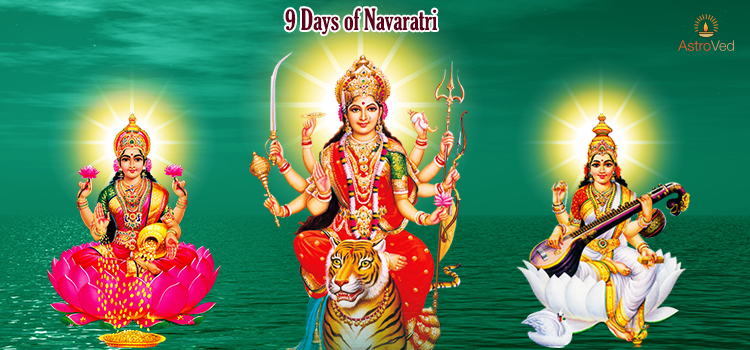There is a palpable excitement in the air as October arrives. For devotees of Shakti, it is time to roll out the red carpet for the Divine Mother – 9 glorious forms of the Goddess – who arrives with great fanfare to grant them their heart’s desires and nudge them forward on their spiritual journey to achieve union with her. It’s time to celebrate one of the most vibrant and colorful festivals of India – Navratri!
One of the major Hindu festivals, Navratri means ‘9 nights of the Goddess’. The festival honors 9 forms of Goddess Durga, who delivered the world from the evil buffalo demon, Mahishasura, after a fierce, 9-day battle. On each day, devotees honor a particular form of the Goddess. The festival is also called Dasara in Karnataka and Durga Pooja in East India (West Bengal). In Tamil Nadu, it is Golu Pandigai.
During this 9-day period, devotees observe a vrat/fast and perform Poojas for the Goddess. In some parts like Gujarat, garba and dandiya dances are organized. During the fast, people avoid certain grains and vegetables as well as alcohol, tobacco, and meat. Such observances help purify the mind and body of the devotees and enable them to connect with the divine during these holy days.
The Goddess signifies cosmic energy, which makes the world function smoothly. So, during the 9 days of the festival, many devotees avoid their usual worldly activities and do meditation to absorb this cosmic energy. The belief is that this energy is present within all of us, and when harnessed properly, it leads to contentment and prosperity.
Each of the 9 forms of Durga has a different appearance and qualities. By worshipping all her 9 forms, devotees seek to receive manifold blessings from her.
Significance of Each Day of Navratri
Day 1
On Day 1, people worship Goddess Shailaputri. She is a form of Goddess Parvati, the daughter of Himavan, who is the king of the mountains. ‘Shaila’ means ‘extraordinary’, ‘one who reaches great heights,’ etc. In this form, the goddess holds a lotus and a trident (trishul) in her hands and sits on a bull. Devotees worship Shailaputri to attain a high state of consciousness.
Day 2
On Day 2, devotees worship Goddess Brahmacharini. In this form, Goddess Parvati performed extreme penance. She represents knowledge and wisdom and adorns herself with rudraksha. She has a water pot in one hand and a rosary in the other. 'Brahma' denotes ‘divine consciousness’, and ‘achar’ means ‘behavior,’, this day is ideal for meditation.
Day 3
Goddess Chandraghanta is honored on Day 3 of Navratri. In this form, the Goddess rides a tiger, symbolizing strength or 'shakti.' Her hands form the Abhaya and Varada mudra (gesture of protection and blessing, respectively). 'Chandra' means ‘moon’, which rules the mind and emotions. A crescent moon adorns her forehead and bestows knowledge and emotional balance.
Day 4
On Day 4, devotees worship Goddess Kushmanda. ‘Kushmanda’ means ‘the creation of the cosmos from a divine egg’. She has 8 arms. One holds a rosary, and the others hold various weapons. Her mount is a tiger, and she bestows the energy for growth on her worshippers.
Day 5
Day 5 is meant for the worship of Goddess Skandamata, the Goddess’ maternal form. Her name means 'mother of Skanda’, and she is depicted with Skanda sitting on her lap. Her mount is a lion. She signifies maternal affection. Worshipping this form of the Goddess bestows wisdom, power, wealth, and prosperity. She has 3 eyes and 4 hands. In two of her hands, she holds lotuses, and the other two display Varada and Abhaya mudras.
Day 6
On Day 6, Goddess Katyayani is worshipped. In this form, she destroys all evil forces that threaten the universe. She kills the buffalo demon Mahishasura. She got her name from Sage Katyayan, in whose ashram she lived while doing penance. She can put an end to our inner turmoil. Her vahana is a lion, and she has 3 eyes and 4 arms. Two arms show varada and abhaya mudras, and the other 2 hold lotuses.
Day 7
Day 7 is for honoring Kalaratri, a very fierce form of the goddess. Her name means ‘dark night.’ She helps us overcome the fear of darkness, and by worshipping her, one can sleep peacefully at night without any fears. The dark-skinned goddess has 4 hands and abundant tresses and is mounted on a donkey. Two hands hold a cleaver and a torch, respectively, while the other 2 show Abhaya and Varada mudras.
Day 8
Day 8 is for honoring Goddess Mahagauri, who represents inner beauty and freedom. She also signifies nature and the energy that propels life forward. Worshipping her helps us gain the energy to propel us forward and attain liberation. Her face is peaceful and compassionate, and in her arms, she holds a drum and a trident. Her mount is a bull.
Day 9
On Day 9, devotees worship Goddess Siddhidatri. She is depicted as sitting on a lotus. She is believed to bestow 26 different wishes on her devotees. She is worshipped by those who wish to attain Siddhis or supernatural powers. She has the power to make possible what seems impossible. She also fulfills desires and grants knowledge and perfection.
Conclusion
Navratri is a time for spiritual rejuvenation. The prayer, chanting, and meditation that we do during Navratri enable us to connect with our spiritual side. This awakens positive qualities within us and destroys negative traits like ego, laziness, pride, cravings, obsession, and aversions, which cause stress. When these negative emotions are destroyed, we experience calm and tranquility. It is like awakening from a deep and restful sleep. We wake up feeling refreshed and rejuvenated. This is how the nine nights of the Goddess transforms our life.


.png)



0 Comments